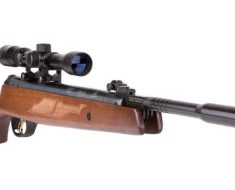“Mastering the kickback, preserving the precision.”
Recoil Management Techniques for Improved Accuracy
Rifle recoil is a common issue that many shooters face when using firearms. Understanding how recoil works and how to manage it can greatly improve your accuracy and overall shooting experience. In this article, we will discuss the basics of rifle recoil, how it can affect your shooting, and some techniques for managing recoil to improve your accuracy.
Rifle recoil is the backward movement of the firearm that occurs when a shot is fired. This recoil is caused by the force of the bullet being expelled from the barrel, which creates an equal and opposite force that pushes the firearm back into the shooter’s shoulder. The amount of recoil can vary depending on the caliber of the bullet, the weight of the firearm, and other factors.
Excessive recoil can negatively impact your shooting accuracy by causing the firearm to move off target after each shot. This can make it difficult to maintain a consistent aim and follow-up shots may be less accurate. In addition, recoil can also cause wear and tear on your firearm over time, leading to potential damage that may require repair.
One way to manage recoil is to use proper shooting techniques. This includes maintaining a firm grip on the firearm, keeping your body in a stable shooting position, and using proper breathing techniques to help absorb the recoil. By practicing these techniques, you can help reduce the impact of recoil on your shooting accuracy.
Another way to manage recoil is to use accessories such as recoil pads or muzzle brakes. Recoil pads are designed to absorb some of the recoil energy, reducing the amount of force that is transferred to the shooter’s shoulder. Muzzle brakes are devices that attach to the end of the barrel and redirect some of the gases produced by firing the bullet, helping to reduce recoil. By using these accessories, you can further reduce the impact of recoil on your shooting accuracy.
If you find that your firearm is experiencing excessive wear and tear due to recoil, it may be necessary to repair or replace certain parts. This can include replacing worn-out springs, buffers, or other components that may be causing excessive recoil. By properly maintaining your firearm and addressing any issues related to recoil, you can help ensure that your firearm remains in good working condition and continues to perform at its best.
In conclusion, understanding rifle recoil and how to manage it is essential for improving your shooting accuracy and overall shooting experience. By using proper shooting techniques, utilizing accessories such as recoil pads and muzzle brakes, and addressing any issues related to recoil through repair and maintenance, you can help reduce the impact of recoil on your shooting accuracy and keep your firearm in good working condition. With practice and attention to detail, you can become a more accurate and confident shooter.
Common Signs of Wear on Rifle Components
Rifle recoil is a natural phenomenon that occurs when a firearm is discharged. It is the backward movement of the rifle caused by the force of the bullet being expelled from the barrel. While some shooters may enjoy the feeling of recoil, it can also cause wear and tear on the rifle components over time. Understanding the signs of wear on rifle components is essential for maintaining the performance and longevity of your firearm.
One common sign of wear on rifle components is excessive recoil. If you notice that your rifle is kicking back more than usual when fired, it could be a sign that the recoil system is not functioning properly. This could be due to worn-out springs or damaged components in the recoil system. It is important to address this issue promptly to prevent further damage to the rifle.
Another common sign of wear on rifle components is a loose or wobbly stock. The stock is the part of the rifle that connects the barrel to the action, and it plays a crucial role in absorbing recoil and providing stability when shooting. If you notice that the stock is loose or wobbly, it could be a sign that the stock screws are loose or that the stock itself is damaged. Tightening the stock screws or replacing the stock may be necessary to restore the stability of the rifle.
Additionally, wear on the barrel of the rifle can also affect its performance. Over time, the rifling in the barrel can wear down, leading to decreased accuracy and increased recoil. If you notice that your shots are not landing where you aim or that the recoil is more pronounced, it may be time to have the barrel inspected by a professional gunsmith. They can determine if the rifling needs to be re-cut or if the barrel needs to be replaced.
In addition to these common signs of wear on rifle components, it is also important to pay attention to the condition of the trigger mechanism. The trigger is a critical component of the rifle that controls when the firearm fires. If you notice that the trigger is sticking, gritty, or has excessive play, it could be a sign that the trigger mechanism is worn out or dirty. Cleaning and lubricating the trigger mechanism can help restore its smooth operation, but if the issue persists, it may be necessary to replace the trigger assembly.
Overall, understanding the signs of wear on rifle components is essential for maintaining the performance and longevity of your firearm. By addressing issues such as excessive recoil, loose stocks, worn barrels, and malfunctioning trigger mechanisms promptly, you can ensure that your rifle remains in top condition for years to come. If you are unsure how to repair or replace worn components on your rifle, it is always best to consult with a professional gunsmith for assistance. By taking care of your rifle and addressing wear and tear issues promptly, you can enjoy shooting with confidence and precision.
How to Properly Maintain and Clean Your Rifle
Rifle recoil is a common issue that many gun owners face when using their firearms. Understanding how recoil works and how to properly maintain and repair wear caused by recoil is essential for keeping your rifle in top condition.
Recoil is the backward movement of a gun when it is fired. This movement is caused by the force of the bullet being expelled from the barrel. The amount of recoil a rifle produces depends on several factors, including the caliber of the bullet, the weight of the gun, and the design of the firearm.
One of the most common issues related to rifle recoil is wear and tear on the gun’s components. Over time, the repeated firing of a rifle can cause parts to become loose or damaged. This can lead to decreased accuracy and reliability, as well as potential safety hazards.
To prevent wear and tear caused by recoil, it is important to properly maintain and clean your rifle on a regular basis. This includes inspecting the gun for any signs of damage, such as cracks or dents, and cleaning the barrel and action to remove any debris or fouling.
When cleaning your rifle, be sure to use the proper tools and cleaning solutions to avoid damaging the gun’s components. It is also important to follow the manufacturer’s guidelines for cleaning and maintenance to ensure that your rifle remains in good working condition.
If you do notice any wear or damage on your rifle, it is important to address the issue as soon as possible. This may involve replacing worn parts, tightening loose screws, or making other repairs to ensure that the gun functions properly.
In some cases, you may need to seek the help of a professional gunsmith to repair damage caused by recoil. Gunsmiths have the knowledge and expertise to properly diagnose and fix issues related to rifle recoil, ensuring that your firearm is safe and reliable to use.
Properly maintaining and repairing wear caused by recoil is essential for keeping your rifle in top condition. By understanding how recoil works and taking the necessary steps to care for your firearm, you can ensure that your rifle remains accurate, reliable, and safe to use for years to come.
In conclusion, rifle recoil is a common issue that gun owners face when using their firearms. Understanding how recoil works and how to properly maintain and repair wear caused by recoil is essential for keeping your rifle in top condition. By following the manufacturer’s guidelines for cleaning and maintenance, inspecting your gun for signs of damage, and addressing any issues promptly, you can ensure that your rifle remains accurate, reliable, and safe to use. If you do encounter any issues related to rifle recoil, don’t hesitate to seek the help of a professional gunsmith to make the necessary repairs. With proper care and maintenance, your rifle will continue to perform at its best for years to come.
Understanding the Impact of Recoil on Shooting Performance
Rifle recoil is a common phenomenon that every shooter experiences when firing a gun. It is the backward movement of the rifle caused by the force of the bullet being expelled from the barrel. Recoil can have a significant impact on shooting performance, affecting accuracy, comfort, and even safety. Understanding how recoil works and how to manage it is essential for any shooter looking to improve their skills.
When a bullet is fired from a rifle, it creates a force that pushes the rifle backward. This force is known as recoil, and it can vary depending on the caliber of the bullet, the weight of the rifle, and other factors. Recoil can cause the shooter to lose control of the rifle, leading to inaccurate shots and potential injury. Managing recoil is crucial for maintaining accuracy and ensuring a safe shooting experience.
One way to reduce recoil is by using proper shooting techniques. By holding the rifle firmly against the shoulder and maintaining a stable shooting stance, shooters can better absorb the recoil and maintain control of the rifle. Additionally, using a recoil pad or muzzle brake can help reduce the impact of recoil on the shooter’s body, making shooting more comfortable and enjoyable.
In addition to affecting shooting performance, recoil can also cause wear and tear on the rifle itself. The repeated force of recoil can damage the stock, barrel, and other components of the rifle over time. This wear can affect the accuracy and reliability of the rifle, making it essential to address any recoil-related damage promptly.
Repairing wear caused by recoil involves inspecting the rifle for signs of damage and addressing any issues that are found. This may include replacing damaged components, reinforcing weak points, or making adjustments to the rifle’s design to better withstand recoil. By addressing recoil-related wear early on, shooters can prolong the life of their rifle and maintain its performance for years to come.
Regular maintenance is also crucial for preventing recoil-related wear and ensuring the rifle functions properly. Cleaning the rifle regularly, lubricating moving parts, and inspecting for signs of wear are all essential steps in maintaining a rifle’s performance and longevity. By taking care of their rifle, shooters can minimize the impact of recoil and enjoy a more consistent shooting experience.
In conclusion, understanding rifle recoil and how it affects shooting performance is essential for any shooter looking to improve their skills. By managing recoil through proper shooting techniques and equipment, shooters can maintain accuracy, comfort, and safety while shooting. Additionally, addressing recoil-related wear through regular maintenance and repairs can help prolong the life of the rifle and ensure its continued performance. By taking these steps, shooters can enjoy a more enjoyable and successful shooting experience.
Repairing and Replacing Worn Rifle Parts for Optimal Function
Rifle recoil is a common issue that many gun owners face when using their firearms. Recoil is the backward movement of a gun when it is fired, caused by the force of the bullet being expelled from the barrel. This recoil can cause wear and tear on various parts of the rifle, leading to decreased accuracy and performance over time. Understanding how rifle recoil works and knowing how to repair and replace worn parts is essential for maintaining optimal function of your firearm.
When a rifle is fired, the force of the bullet being expelled from the barrel creates a reaction force that pushes the gun backward. This recoil can be felt by the shooter as a jolt or kick, and it can also cause the rifle to move off target. The amount of recoil a rifle produces depends on several factors, including the caliber of the bullet, the weight of the gun, and the design of the rifle’s action.
One of the most common parts of a rifle that can be affected by recoil is the stock. The stock is the part of the rifle that the shooter holds against their shoulder, and it helps to absorb some of the recoil when the gun is fired. Over time, the stock can become worn or damaged from repeated recoil, leading to cracks, splits, or other issues that can affect the rifle’s accuracy and performance.
If you notice any damage to the stock of your rifle, it is important to repair or replace it as soon as possible. Repairing a damaged stock can be done using a variety of methods, depending on the extent of the damage. Small cracks or splits can often be repaired with wood glue or epoxy, while more extensive damage may require the stock to be replaced entirely.
In addition to the stock, other parts of the rifle can also be affected by recoil and wear. The barrel, action, and trigger mechanism are all critical components of a rifle that can be damaged over time from repeated firing. Regular maintenance and inspection of these parts are essential for ensuring that your rifle functions properly and safely.
If you notice any wear or damage to these parts, it is important to address the issue promptly. Replacing worn or damaged parts can help to restore the rifle’s accuracy and performance, and it can also help to prevent further damage from occurring. Many gun owners choose to work with a qualified gunsmith to repair or replace worn parts, as they have the expertise and tools needed to ensure that the job is done correctly.
In conclusion, understanding rifle recoil and knowing how to repair and replace worn parts is essential for maintaining optimal function of your firearm. Recoil can cause wear and tear on various parts of the rifle, leading to decreased accuracy and performance over time. By regularly inspecting and maintaining your rifle, you can ensure that it functions properly and safely for years to come. If you notice any damage to the stock, barrel, action, or trigger mechanism, it is important to address the issue promptly to prevent further damage and maintain the rifle’s performance. Working with a qualified gunsmith can help to ensure that any repairs or replacements are done correctly, so you can continue to enjoy using your rifle for years to come.





